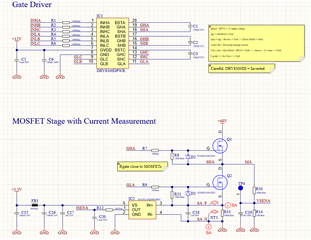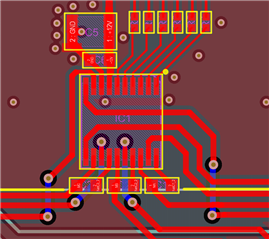Other Parts Discussed in Thread: DRV8300
Hi,
I made a design with a DRV8300DI gate driver IC for a motor control application. The problem that occurs is,
that when I give a PWM signal to INHx/INLx combo, I get no output PWM signal for the gate and I'm unsure, what I'm doing wrong.
For the PWM generation I took a C2000 uC and the DRV8300DI receives the PWM signals fine. The supply voltage is 12V and looks also fine.
The BSTx voltage is around 5V, but this is probably because there is no PWM for bootstrapping. Also the DRV8300DI nFault pins stays high (pull up).
There is no motor attached, just the gate driver that receives the PWM signal and does not forward it to the MOSFETs.
The schematic for the gate driver with one half bridge is depicted here:
(Note: I used the DRV8300DI and not the DRV8300D)
(Note: There are 4x220uF bulk and a lot of ceramic directly at the MOSFETs)

Layout:


I'm currently out of ideas what I'm doing wrong.
Edit: One thing I see is, that when I let INLx to GND and just PWM on INHx, I get a PWM signal for GLx. So it seems, that the 2-Channel PWM from the C2000 does make some trouble with this controller.
Edit2: Might this be a problem with a undervoltage lockout? The voltage from BSTx to SHx is around 7V at startup (probably through the voltage dividers from GHx to SHx and there to the VSENSx measurement. BTW I use 50% PWM signals for INHx and INLx





